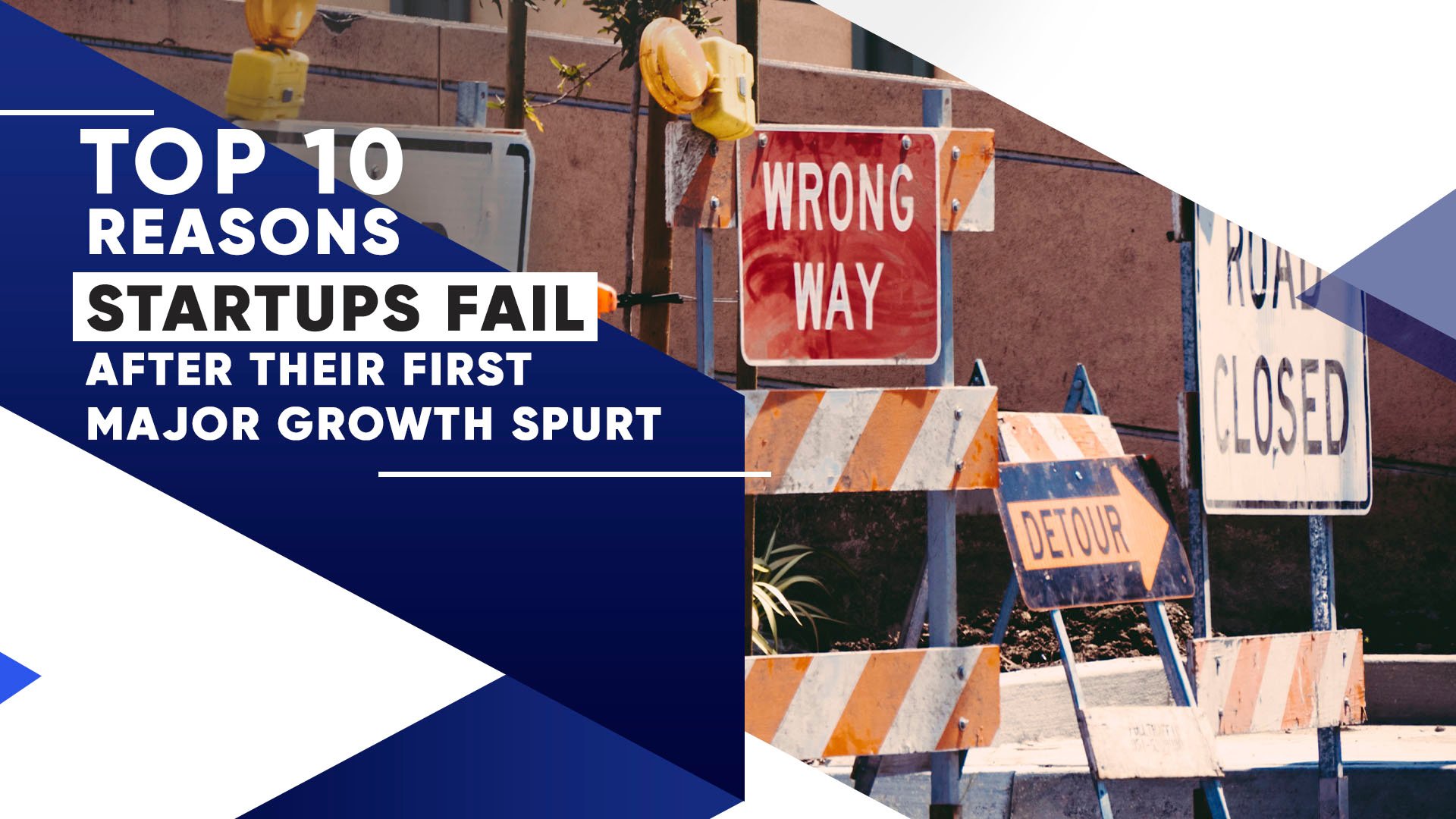Top 10 Reasons Startups Fail After Their First Growth Spurt

Experiencing a major growth spurt in your business for the first time?
Then chances are, you’ll be making some mistakes. Though some are a natural part of the growth process, the rest should be avoided at all costs. And here’s your chance to learn from those who ventured out before you.
Growing from a startup or mid-market company into a scale-up is a challenging transition. Even the most experienced CEO or executive will admit that growing pains are inevitable once you start scaling. However, the faster you overcome the hurdles, the smaller the chance your business fails.
One of the biggest problems when you lack experience with scaling up, is that you don’t know what you don’t know. But fortunately for you, others have already made some mistakes in the process. Knowing what they are can help you prevent them.
Over the past decade, I have personally helped thousands of startups and mid-market companies move from one phase to the next. By now, more than 70,000 companies have successfully scaled up with my elaborate framework of tools and tactics, the Scaling Up methodology, which is described in detail in my bestselling book Scaling Up: How a Few Companies Make It…and Why the Rest Don’t.
One of the main reasons CEOs and executives of fast-growing companies struggle and fail is that they try too many things at the same time. It’s really important to have focus, be disciplined, and gather the data you need to be able to know what works and what doesn't.
Here, I’ve listed 10 of the most common and dangerous mistakes CEOs and executives of scale-ups make that you can avoid.
1. Scaling up too fast
One of the most common mistakes companies in the startup phase make is that they scale up prematurely. After getting one or two clients, they believe they have already proven their market-fit.  Although the excitement is understandable, you really have to validate your business model before you scale. Because even when you already have more than one or two clients or users as a startup, you still have to gain traction on the main market.
Although the excitement is understandable, you really have to validate your business model before you scale. Because even when you already have more than one or two clients or users as a startup, you still have to gain traction on the main market.
Geoffrey Moore wrote an interesting book about this phenomenon, called Crossing the Chasm. It describes the challenge of getting from very few buyers to a lot of buyers. You have to realize that at first, it’s the early adopters that are buying your product; people who generally like to try new things. But after that, you need to reach the majority. The majority of buyers are very different and the gap between the two can be a difficult one to bridge. Therefore, this point is also the one in which most companies get stuck or even go down entirely. Make sure to test your product-market-fit thoroughly and that you know exactly who your ideal customer is.
Also, without proper preparation and strategic focus, rapid growth does not necessarily mean profitability. You have to be ready to scale. CEO and Co-founder of Fracture, Abhi Lokesh, said they had to learn this in his company the hard way: “It’s a euphoric feeling to see orders flood in, but you have to make sure you’ve got an ironclad grasp on the unit economics of those orders and the efforts that led to those orders. How much did you pay for them? Are they actually profitable?”
Lokesh’ advice was not to be seduced by top-line numbers: “Along with rapid growth also comes additional overhead costs – more employees, more infrastructure, more everything. Are you truly prepared to handle it? We weren’t, and it cost us dearly.”
In any growth phase, dig deep to ensure that the growth is sustainable and you can actually keep it up. Otherwise, you’re not scaling at all – you’re just getting bigger and less efficient.
2. Lack of focus and alignment
When your company is gaining more traction, the decisions you need to make grow even more complex. This pressure can cause you to make poor decisions that can hurt your potential for success and even set you back.  More companies die for the excess of opportunity than for lack of it. To prevent overwhelm, (excessive) stress, and disorganized movement in all directions, it’s essential to know exactly what your focus is.
More companies die for the excess of opportunity than for lack of it. To prevent overwhelm, (excessive) stress, and disorganized movement in all directions, it’s essential to know exactly what your focus is.
This means you’re deliberately choosing what to do, but also – and equally important – deliberately choosing what not to do.
Don’t go crazy trying to add new features or related products once you’ve achieved product-market-fit and started scaling up. It’s important that you can do one thing better than anyone else before you start building new stuff.
A great tool that you can use in your organization to gain more clarity on what your focus should be at any point in time, is the One-Page Strategic Plan or OPSP. This is a very concise plan that’s easy to communicate with your entire team. This one-page document will literally get your employees on one page and achieve team alignment.
You need to have the right goals and metrics in place and these need to be clear and transparent for everyone on your team. Because without alignment, focus, and commitment, fast growth isn’t sustainable.
Everyone makes mistakes but the key is being aware of them. This is the only way can discover what works and what doesn’t. It’s how we distinguish smart, well-informed decisions in your business from the opposite. What you don’t track and measure, you cannot improve.
The daily huddle is also an effective tool that helps you and your team(s) to remain flexible without losing alignment or focus. This is a 5-15 minute meeting to discuss tactical issues and provide updates. It’s part of a proven meeting rhythm that many of the most successful entrepreneurs in the world implemented in their organization to enable their major, rapid growth. You can read more about effective meetings in my article “How Weekly Meetings Can Accelerate Your Firm’s Growth, Keep Everyone Motivated, And Achieve Your #1 Priority”.
3. Hiring prematurely
Another common mistake startups tend to make in their first period of significant growth is to hire too fast. Jeremy Ong, the owner of HUSTLR and a chain of blogs and eCommerce stores, learned this the hard way: “One of the biggest mistakes I've made when my company was experiencing rapid growth was to hire people prematurely because we were just desperate for extra manpower just to cope with the demand.”
“As a result, I have hired employees that do not fit into the company culture at all, which hurt company morale in ways I didn't imagine. Employees started sharing bad habits with each other and the productivity per employee dropped because of the distractions and the poor performance of other employees. We ended up being less productive as a company, even with more people.”
Jeremy was hoping things would improve over time but eventually had to dismiss the bad apples after a series of poor performances spanning over a year and a half. The company had to undergo a culture rehabilitation exercise to get the best employees back on track.“I now believe that it is better to push our best employees harder and treat them better, instead of using a duct-tape solution by hiring employees just because we’re in need of more manpower.” Matthew Ross, Co-owner and COO of The Slumber Yard had a similar experience due to hiring too quickly without the proper interviews and screening: “After a couple of weeks, it was apparent that we had hired the wrong candidates. Whether they didn’t possess the skills necessary to succeed in the position or didn’t fit into the company’s culture from a personality standpoint, these hires actually hindered the company’s growth.”
Matthew Ross, Co-owner and COO of The Slumber Yard had a similar experience due to hiring too quickly without the proper interviews and screening: “After a couple of weeks, it was apparent that we had hired the wrong candidates. Whether they didn’t possess the skills necessary to succeed in the position or didn’t fit into the company’s culture from a personality standpoint, these hires actually hindered the company’s growth.”
His advice: “Take your time and really train up each new employee. If you're constantly trying to rush, you may find yourself getting out over your skis.”
It’s also important to remember that you need to stay lean. Don’t hire too many people (middle managers or specialists) as this takes away from your core competencies and leave you prone to trying to scale other areas too quickly. A small, motivated, and highly productive team is better than a sluggish team with poor morale.
But don’t postpone hiring new employees too long either as failure to deliver is at the core of many business closures. Just make sure to hire efficient resources that believe in your vision. And don’t forget that especially amidst rapid growth, outsourcing can be a great solution for non-core tasks too.
4. Mistaking leadership for management
When your company is still in its initial startup phase you may be able to handle all of the functional roles, but it's a fatal mistake to believe you can continue to do so.  To stay on the path toward achieving your BHAG (Big, Hairy, Audacious Goal), stick with leading, don’t start managing. Shyam Krishna Iyer, the founder of SKI Charities, experienced the consequences of getting too managerial as a business leader. He said: “While an entrepreneur may drive early success, I have found successful entrepreneurship to be far more "bottom-up" as local level ownership and buy-in will determine the success of any project or enterprise.”
To stay on the path toward achieving your BHAG (Big, Hairy, Audacious Goal), stick with leading, don’t start managing. Shyam Krishna Iyer, the founder of SKI Charities, experienced the consequences of getting too managerial as a business leader. He said: “While an entrepreneur may drive early success, I have found successful entrepreneurship to be far more "bottom-up" as local level ownership and buy-in will determine the success of any project or enterprise.”
When Shyam started out, he decided that a high level of oversight and control would be necessary but he soon learned this was not scalable: “I quickly became stretched too thin and lost the connection with my staff on the ground. The entire enterprise began to lose focus and flounder.” He found that autonomy and control must devolve from the entrepreneur to the field in order to scale successfully.
Business leaders inspire others, have the vision, make connections, and secure funding for their companies’ continued growth. They’re idea machines. These are not necessarily the same qualities found in a good manager. It’s important to leave the execution to those who are great at that.
5. Not setting long-term goals
Goals give you direction and keep you on track during the day-to-day operations. By making sure your goals are SMART, you can identify where you want to go and outline the specific action steps needed to get there. This is something most business leaders understand and do well. But although most startups and scale-ups do set short-term goals (monthly, quarterly, yearly, and perhaps also 2- to 5-year goals) to measure their progress, they often fail to define long-term ones too. If the long-term is not clearly defined, your short-term goals might end up being the wrong ones.
But although most startups and scale-ups do set short-term goals (monthly, quarterly, yearly, and perhaps also 2- to 5-year goals) to measure their progress, they often fail to define long-term ones too. If the long-term is not clearly defined, your short-term goals might end up being the wrong ones.
Long-term goals are often overlooked in startups for reasons (or excuses) of agility but if you want to move fast, you need to know where you are going. You have to be able to make quick but smart decisions. And this requires a clear sense of direction.
Coming up with a Big, Hairy, Audacious Goal (BHAG) that you’re striving towards the next 10 to 20 years can help you with that.
6. Saying yes to every customer request (“over-customizing”)
Another mistake that fast-growing companies often make when they start to scale-up, is that they say yes to every (feature) request made by their customers. In this case, you’re running the risk of over-promising and under-delivering.
This is also what the Co-founder of GreenPal (a company described as “Uber for lawn care”), Gene Caballero, experienced: “One mistake we made when trying to scale, was to give our customer too much power when it came to dictating their schedule. We allowed homeowners the chance to add one-at-a-time appointments whenever they wanted and didn't give them the ability to easily schedule either weekly or biweekly appointments. This is a logistical nightmare for the lawn care pros that used our platform.”
They decided to implement a change that forced homeowners to opt for a regular routine. This ultimately provided them with better service from the vendors, who in their place were more engaged since, knowing that the homeowners they obtained via GreenPal were in it for the long haul. “This has helped us grow at over 100% YoY. Our projected revenue for 2019 is $20m,” said Caballero. The saying they have at their company is one that could be useful for many to remember in the scale-up phase: "We let the thousands decide what the millions will do."
7. Focusing on marketing too little or too late
 One of the biggest, most persistent mistakes startup founders make is assuming they don't need to market and that their customers will find them. Many believe that marketing is a function they can do without for the longest time and they almost always use it as a last resort to gain traction. But thinking you can create a major, sustainable growth organically is very naïve. And word-of-mouth referrals and direct marketing do not scale.
One of the biggest, most persistent mistakes startup founders make is assuming they don't need to market and that their customers will find them. Many believe that marketing is a function they can do without for the longest time and they almost always use it as a last resort to gain traction. But thinking you can create a major, sustainable growth organically is very naïve. And word-of-mouth referrals and direct marketing do not scale.
Obviously, the best type of marketing for you depends on your business and your target audience. But whether it’s traditional advertising, online marketing or content marketing, you’ll need something to scale, and that something has to be a strategic choice with clear KPIs and ROIs that are well measured.
Too little strategic focus on marketing can also result in becoming dependent on one marketing channel only. And like Abi Lokesh from Fracture experienced, this is inadvisable too: “One mistake we made at Fracture while scaling was putting all of our growth eggs in one basket. We rode the wave of what helped us achieve scale, somewhat naively hoping that it would never end, without taking advantage of that opportunity to diversify our marketing efforts.”
Lokesh learned that “you’ve always got to have multiple irons in the fire”: “Sooner or later, a marketing channel will peak and begin to lose efficiency. Don’t wait until that happens, because by then it’s too late. Recognize that every scaling tactic has an expiration date and keep working to find the next growth hack.”
8. Postponing the next-round funding too long
Running out of money should be avoided at this stage, so have your action plan in place early on and get ready to impress investors earlier than you may have intended.  Venture Capital firms that invest in later-stage funding are more risk-averse than your early-stage or pre-revenue investors. It usually takes much longer to attract them and seal the deal. But you need fast cash to grow your facilities.
Venture Capital firms that invest in later-stage funding are more risk-averse than your early-stage or pre-revenue investors. It usually takes much longer to attract them and seal the deal. But you need fast cash to grow your facilities.
Hunting down funding almost becomes a CEOs full-time job if it’s not approached strategically and you don’t partner with investors for the long run. This is what Kim Saxton, MBA, PhD, and Clinical Professor of Marketing, found and described in the book she co-authored, The Titanic Effect: Successfully Navigating the Uncertainties that Sink Most Startups: “To grow means having enough cash on hand to make investments in sales, marketing, and people to support customers. Often early on, startups are interested in any source of funds. They don’t vet their investors. They need to partner with investors who can fund successive rounds of investment. Instead, they end up having to hunt down new sources of funds. That takes time and the process is slow. So, it’s hard to match up funding time with needs for cash to grow.”
Apart from the difficulties that business leaders may experience in their quest to impress investors, it also becomes more difficult to estimate your expenditure correctly in the scale-up phase. William Taylor, currently CDO (Career Development Officer) at MintResume, had this experience while running a previous company of his: “Initially, we thought that we wouldn't be needing additional staff as we already had a well-trained team that was good at multitasking. But, we soon realized that we needed more people as our team was already overworked and struggling with time management issues. So, we hired a new team. To accommodate this cost, we compromised on the office renovation and our higher management had to pool in a few resources to meet our expenses.”
You never miss the water until the well runs dry, but if you wait until the last minute to seek funding this can lead to extremely tight and stressful situations that could threaten your company’s very existence.
9. Lacking a scalable infrastructure
As your company grows, nothing scales automatically, unless it is systematically set up for scale. You need to have the right infrastructure in place – systems, procedures, and physical space – in order to keep the pace and make optimal use of your company’s momentum.  To expect communication naturally evolves with growth, for instance, is a false assumption many startup founders make. It’s obviously a lot easier to communicate changes and progress to a few other people, versus 10, 50 or even 1000 other people.
To expect communication naturally evolves with growth, for instance, is a false assumption many startup founders make. It’s obviously a lot easier to communicate changes and progress to a few other people, versus 10, 50 or even 1000 other people.
Fracture founder Lokesh also learned that you shouldn’t take good communication at scale for granted; you’re going to have to work at it: “During rapid growth, it’s much easier for messaging to get misinterpreted, key points to get lost, and dangerous assumptions to be made. You have to invest in your company’s communication infrastructure to make sure everyone gets and stays on the same page.”
Your IT infrastructure has to be set up properly too. This does not only mean having the right systems in place for communication and execution; it also means investing in redundancy. As Deni Ivanov, CEO and CMO of Royal Services could illustrate from his experience. He admitted they didn't invest heavily enough in their company's online infrastructure “We didn't think about the fact that you should make backups for almost everything you work on. Redundancy is of huge importance as we try to keep all of our information online and all of our communications are done in one form or another over the internet. You need to have backups for whenever a system crashes or an email gets deleted by accident – we learned the hard way.”
10. Not being agile

Strategic action plans are important to achieve your vision but they can't be written in stone either. Unforeseen situations occur, market trends change and aggressive competitors can pop up out of nowhere. Consequently, you may need to change course quickly at one point or another.
Change is the only constant, especially in startups and scale-ups. Don’t to pivot for the sake of pivoting but if you become stubborn or paralyzed, you will stall out.
A strong IT infrastructure and communication system can help you iterate. Making small, daily, incremental changes that are aligned with your company’s long-term vision or BHAG and that contribute to your most important KPIs, is the best way to ensure agility.
If you’re experiencing hiccups on your road to major business success, know that you’re not the only one in battle (regardless of the type of product or service you provide or the industry you’re in).
Always remember that for every problem you encounter, another company has already faced something similar, and you can implement the tools and strategies that have proven to work.



